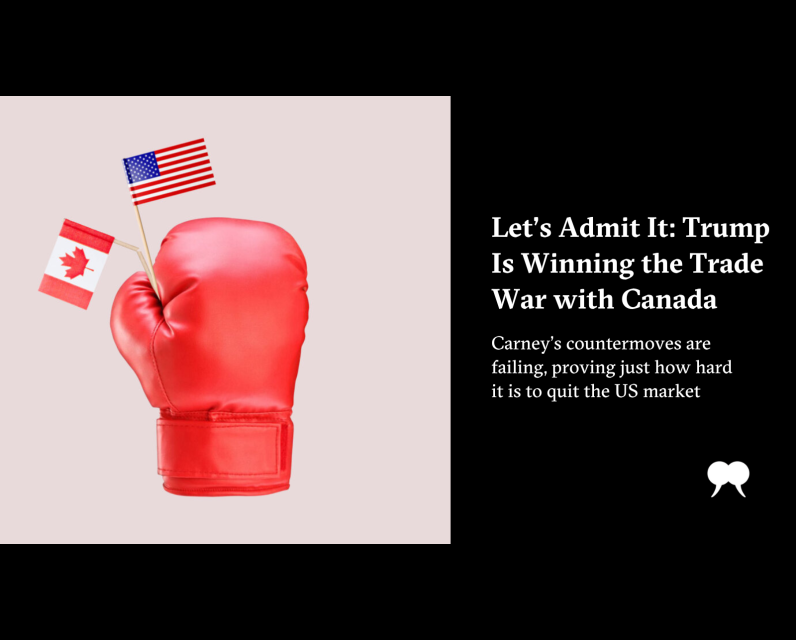Let’s Admit It: Trump Is Winning the Trade War with Canada

A few weeks ago, I ran into somebody involved with the Canada–US trade talks. Can’t get more specific than that. When I asked how it was going, this person bugged their eyes out, since miming was probably safer than using words. “Must be like negotiating with a roulette wheel,” I offered. This person didn’t disagree.
On July 25, ahead of the tariff deadline, the American president sounded like he’d just been reminded Canada exists. “We don’t have a deal with Canada, we haven’t been focused on it,” Donald Trump said, doing his best imitation of Jordan Catalano from My So-Called Life. Dreamy or catatonic? Can’t he be both? We had a July 21 deadline, we had an August 1 deadline. Dominic LeBlanc says they’re “complex negotiations.” Trump says it’s “not really a negotiation.” One of them’s got to be right. Or not.
All over, there are signs of flagging motivation. British Columbia premier David Eby gave an extraordinary interview to Bloomberg, where he questioned the wisdom of further counter tariffs. The rebuttals Eby announced with some fanfare on February 1 “haven’t seemed to have had the kind of impact that we would hope for,” he says now. Adding another layer of Canadian counter tariffs might inflict “severe harm” on British Columbians without making Trump budge.
Eby’s willingness to think out loud and adjust course is among his most refreshing qualities, but it’s worth noting that in February, questioning the virtue of countermeasures was one of the things that threatened to get Alberta premier Danielle Smith barred from civilized society. Eby has begun to reach conclusions that once seemed taboo. Mark Carney is somewhere between Smith and Eby: he’s lately been in less of a hurry to seek the most theatrical response to the latest Trump sortie.
This is all deeply unsatisfying, but it may be that there is no satisfying way to respond to Trump. As the summer wears on, there is a notable droop to the once proudly waving Canadian elbow.
P ete Hoekstra, Trump’s man in Ottawa, recently said something goofy. What’s really interesting is the response he got. I’m indebted to Politico’s Canada Playbook for this. “Where I’ve been for the last 90 days, there’s no advocates for the Canadian-American relationship,” Hoekstra told a business conference. “So, when people now come to me and say, ‘Well, you know, your favorability has gone down, and China’s has gone up . . . what’s the surprise here?” Hoekstra asked. “There’s nobody been advocating for the strength of the relationship.”
And it’s true! Where are the Canadians who are eager to pay more to do business in a country where there’s been a measurable increase in the risk of being persecuted for thoughtcrime or threatened with annexation?
Turns out they’re everywhere! Politico hoovered up these quotes from business leaders. Business leaders agree that “it’s time for both countries to work toward a renewed, reliable relationship,” said Candace Laing from the Canadian Chamber of Commerce. “Canada’s business community will continue to be a vocal champion for a thriving, integrated North American economy that remains the envy of the world.”
Added Beth Burke from the Canadian American Business Council—which, to be fair, would cease to exist if there were no business between Canadians and Americans: “Across sectors and the border, companies and business groups are engaging deeply, often behind the scenes, to keep this relationship strong and forward-looking.”
And Goldy Hyder from the Business Council of Canada added: “Having spoken to the ambassador many times, I know he would like to see the temperature turned down on both sides and frankly, we agree.”
On Substack, political strategist David Herle called these the remarks of “weaklings.” I think it’s possible to read them a few ways.
One: for each of these quotes, it’s easy to imagine an implied but unspoken second part, which is that the main obstacle to “a renewed reliable relationship” in a “strong and forward-looking” relationship is one guy who rewrites tariff levels every night before bedtime.
But also, two: it’s not weak for a business association to defend the interests of business. If you’re in the business of selling widgets, what’s the ideal end to Trump’s tariff adventure? Surely, it’s that Trump changes his mind, or loses the midterms, or is replaced by a classic Clinton-era free-trading Democrat—that, one way or another, the US simply stops being weird and goes back to being the vast and easy market it’s been for most of our lifetimes.
But here’s where it gets tricky. Short of that ideal outcome, what’s next best? At 15 percent tariffs on everything Canadian, for many if not most Canadian exporters, getting over the tariff wall and into that vast market is probably a better outcome than the three main alternatives: abandoning exports; taking a flyer on distant and, in many cases, saturated third markets like Europe; or adding Canadian counter tariffs to American tariffs for spite.
(I use “getting over the tariff wall” here because the answer to who pays tariffs is often “a bunch of people.” The importing company pays but often passes costs on to consumers in the form of higher prices—and to exporters in the form of reduced demand for their goods.)
I’ve written this before: replacing a lifetime of ever-closer integration with the vastly larger population next door, in favour of substantial new partnerships with distant lands, is really hard. Actually, it’s usually impossible. That’s one of the lessons of Brexit. Europe remains Britain’s overwhelming export market; it’s just that voters decided in 2017 to make it harder to access that market. Attempts to compensate for lost EU market access with trade breakthroughs in third countries have gone terribly.
Any list of the people on Earth who’ve studied this dynamic most closely would have to include Mark Carney.
C arney came to office with a plan to respond to Trump: dissuade Trump; seek compensating growth in third markets outside the US; and seek compensating growth inside Canada, through the “One Canadian Economy” push for liberalized internal trade. It should have been obvious from the outset that all three parts of that plan would be huge challenges. Now it’s more obvious, because experience has made us half a year wiser.
Dissuade Trump? See above. Third markets? By my very rough calculation, if Canada–US trade declined by 10 percent but trade between Canada and South Korea quintupled, we’d be no further ahead. There aren’t a lot of rabbits to be pulled from those distant hats.
Internal trade? In Huntsville this week, Eby signed “trade” “agreements” with the governments of Ontario, Manitoba, and Yukon. I couldn’t find the text of the agreements on the BC government’s website, but here’s the deal Eby signed with Doug Ford. It amounts to a solemn undertaking to try to keep the cat from eating tomorrow’s homework.
“The Parties will strive to ensure” that “a like good, service or occupation” you could buy in one province can be bought in another, the “agreement” says. They’ll “work . . . together to identify options to further align regulated occupations and registration.”
My favourite: They’ll “work together on a bilateral framework for a direct-to-consumer (DTC) system, as well as with all other interested Canadian jurisdictions to establish a pan-Canadian framework for DTC access to alcoholic beverages.”
You could drive a truck through this “deal.” But just in case someone tries, the inspiring last paragraph of the “agreement” specifies that it “is not legally binding and does not create any legal, equitable or financial rights, obligations or liabilities for either of the Parties.”
Without that last paragraph, deals like this would go some distance toward creating “One Canadian Economy” for trade lawyers. With that last paragraph, it’s perfectly meaningless and should trouble you no further.
It’s James Moore who sent me looking for the text of the BC–Ontario deal. I sent him an email with the gist of the argument you’re reading here, and he sent back some thoughts. Moore was a senior minister in Stephen Harper’s federal government who announced a pan-Canadian agreement on internal trade in 2014. It was better than nothing, and full enough of holes that everyone spent the first part of 2025 promising to do better.
But doing better is hard. “The linchpin of any free trade agreement is enforcement and the willingness of provinces to surrender some sovereignty and abide by the external adjudication of disputes,” Moore wrote to me. “So, for example, if Alberta discriminates against a Nova Scotia engineering company who wants to bid on government procurement to build public transit . . . and 90 percent of Albertans want the contract to go to an Alberta engineering firm, will the Alberta government surrender to the ruling of non-discrimination against a Halifax firm? Or will they pay some nominal fine and carry on with the local bid?”
That’s why an agreement to work toward frameworks for identifying options ends with a paragraph that carefully reminds anyone not to believe any of it. “Who’s actually committed to macroeconomic liberalization in theory when micro-political pressure is more alluring?” Moore wrote. “That’s the question.”
It’s definitely one of many. These are the dog days of summer, and I don’t have snappy solutions to any of this. We are, simply, gathered here today to remind one another that all of this is hard.
B ut maybe I can hazard some guiding principles.
With regard to a US that generated Trump and keeps generating Trump disciples: it will still, always, forever, be by far the largest basin of economic opportunity within a day’s truck drive from Windsor. Everything will go easy if the Americans work in their best economic interest, but Canadians can’t compel them to. We are stuck making our own decisions based on our own interest.
With regard to the rest of the world: Canada basically isn’t in the game when it comes to seeking new, expanded export markets in the Americas, Europe, Asia, or Africa. It could stand to triple its effort. Start with the easy stuff, like finally naming a new ambassador to Germany or having the prime minister attend the Halifax International Security Forum. But understand: even greatly expanded effort overseas won’t compensate for severe erosion in the Canada–US relationship.
With regard to the One Canadian Economy: it would be nice if it happened. Here, the federal government could stand to be less nice. A public online list of provincial barriers to trade, updated weekly, would be a handy name-and-shame exercise.
The problem with One Canadian Economy is that the second word seems to swamp the others. It’s, you know, a Canadian economy: poky, hidebound, haunted by hopes and wishes, innocent of effort. It took a lifetime to get here and will take a lifetime to get out, if there is any getting out.
Adapted from “Elbows at mid-mast” by Paul Wells (Substack). Reprinted with permission of the author.
The post Let’s Admit It: Trump Is Winning the Trade War with Canada first appeared on The Walrus.


Comments
Be the first to comment